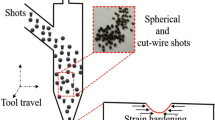Abstract
Residual stresses are one of the causes of failures in structural components. These stresses may arise in the fabrication process from many causes. They cannot be easily accounted for because they are both difficult to predict and to measure. X-ray diffraction (XRD) is nowadays a widespread technique for measuring surface residual stresses in crystalline materials. Very small specimens are often used for this purpose due to geometrical restrictions of either the diffractometer sample holder or the component to be inspected. However, the cutting process itself may affect the residual stress state in these specimens, so measured stresses could be misleading. In this work, the influence of specimen length on residual stresses was investigated in cold-drawn ferritic and pearlitic steel wires by XRD measurements and finite element simulations. In the ferritic wires, numerical simulations coincide with experimentally measured stresses. However, in the pearlitic wires the effect of the stresses in cementite (which could not be measured by XRD) has to be taken into account to explain the observed behavior. The results obtained have shown that in both materials the cutting process affects residual stresses, so it is recommended that specimens larger than five times the wire diameter be used.
Similar content being viewed by others
References
CUR: “Cases of Damage to Corrosion of Prestressing Steel,” Netherlands Committee for Concrete Research, Report 49, The Hague, The Netherlands, 1971.
E. Philips: “Survey of Corrosion of Prestressing Concrete Water-Retaining Structures,” Australian Water Resources Council, Paper 9, Canberra, Australia, 1975.
M. Elices, G. Maeder, and V. Sánchez-Gálvez: “Effect of Surface Residual Stress on Hydrogen Embrittlement of Prestressing Steels,” Brit. Corr. J., 1983, 18, pp. 80–81.
J. LLorca and V. Sánchez-Gálvez: “Fatigue Limit and Fatigue Life Prediction in High Strength Cold Drawn Eutectoid Steel Wires,” Fatigue Frac. Eng. M., 1989, 12, pp. 31–45.
J. LLorca and V. Sánchez-Gálvez: “Numerical Determination of the Influence of Residual Stresses on Fatigue” in Computational Plasticity, D.R.J. Owen, E. Hinton and E. Oñate ed., Pineridge Press, Swansea, UK, 1987, pp. 1123–36.
P.J. Webster and G. Mills: “Residual Stresses in a Steel Strand,” Physica B, 1997, 241–243, pp. 1270–73.
K. Katagiri, T. Sato, K. Kasaba, S. Sasaki, and H. Tashiro: “Effects of Post-Drawing Treatments on the Fatigue Strength of Eutectoid Steel Wires,” Fatigue Frac. Eng. M., 1999, 22, pp. 753–60.
S. Beretta and M. Boniardi: “Fatigue Strength and Surface Quality of Eutectoid Steel Wires,” Int. J. Fatigue, 1999, 21, pp. 329–35.
A. Ben Rhouma, C. Braham, M.E. Fitzpatrick, J. Lédion, and H. Sidhom: “Effects of Surface Preparation on Pitting Resistance, Residual Stress, and Stress Corrosion Cracking in Austenitic Stainless Steels,” J. Mater. Eng. Perform., 2001, 10(5), pp. 507–14.
I.C. Noyan and J.B. Cohen: Residual Stress: Measurement by Diffraction and Interpretation, Springer-Verlag, New York, NY, 1987.
K. Van Acker: “Inwendige Spanningen in Koudvervordme Metalen en in Metaalmatrixcomposieten,” Ph.D. Thesis, K.U. Leuven, Belgium, 1996 (in English).
V. Hauk and E. Macherauch: “A Useful Guide for X-Ray Stress Evaluation,” Adv. X Ray Anal., 1984, 27, pp. 81–99.
K. Masubushi: Analysis of Welded Structures. Residual Stress and Distortion and Their Consequences, Pergamon Press, Oxford-New York, 1980.
J. Peters, R. Snoeys and M. Mars: “Residual Stress in Grinding” in Advanced Fabrication Processes, Proc. Agard, Conference Proceedings, Neuilly Sur Seine, France, 1978, 256, pp. 2.1–2.15.
E. Schneider and K. Goebbles: “Determination of Mechanical Stress by Polarized Shear Waves” in New Procedures in NDT, P. Holler ed., Springer Verlag, Berlin, Germany, 1983, pp. 551–60.
B. Sundström and K. Törrönen: “The Use of Barkhausen Noise Analysis in Nondestructive Testing,” Mater. Eval., 1979, 2, pp. 51–56.
S. Sharma, H. Mao, P. Bell and J. Xu: “Measurement of Stress in Diamond Anvils With Micro Raman Spectroscopy,” J. Raman Spectrosc., 1985, 16(5), pp. 350–51.
S. Carlsson and P.L. Larsson: “On the Determination of Residual Stress and Strain Fields by Sharp Indentation Testing. Part I: Theoretical and Numerical Analysis,” Acta Mater., 2001, 49, pp. 3179–91.
I.C. Noyan: “Effect of Gradients in Multi-Axial Stress States on Residual Stress Measurements With X-Rays,” Metall. Trans. A, 1983, 14A, pp. 249–58.
R.W. Hertzberg, Deformation and Fracture Mechanics of Engineering Materials, 9th ed., John Wiley and Sons, New York, 1996, pp. 10–16.
J.M. Atienza: “Tensiones Residuales en Alambres de Acero Trefilados,” Ph.D. Thesis, Universidad Politécnica de Madrid, Spain, 2001 (in Spanish).
Hibbitt, Karlsson, and Sorensen Inc.: ABAQUS Manual, version 5.8, Pawtucket, RI, 1998.
T. Hamada, T. Hirouchi, and M. Akiyama: “A Numerical Study of Temperature in a Fine High Carbon Steel Wire Subjected to High Speed Drawing,” Wire J. Int., 2001, 34(5), pp. 86–92.
O.C. Zienkiewicz and R.L. Taylor, The Finite Element Method, 9th ed., McGraw-Hill, London, UK, 1989.
A.J.L. Crook and E. Hinton: “Comparison of 2d Quadrilateral Finite Elements for Plasticity Problems” in Computational Plasticity, D.R.J. Owen, E. Hinton and E. Oñate, ed., Pineridge Press, Swansea, UK, 1989, pp. 181–95.
K.J. Bathe, M. Kojic, and J. Walczak: “Developments in Methods for Large Strain Elasto-Plastic Problems” in Computational Plasticity, D.R.J. Owen, E. Hinton and E. Oñate, ed., Pineridge Press, Swansea, UK, 1989, pp. 263–75.
K. Van Acker, J. Root, P. Van Houtte, and E. Aernoudt: “Neutron Diffraction Measurement of the Residual Stress in the Cementite and Ferrite Phases of Cold Drawn Steel Wires,” Acta Metall. Mater., 1996, 44, pp. 4039–49.
Y. Tomota, P. Lukás, D. Neov, S. Harjo, and Y.R. Abe: “In Situ Neutron Diffraction During Tensile Deformation of a Ferrite-Cementite Steel,” Acta Mater., 2003, 51(3), pp. 805–17.
Author information
Authors and Affiliations
Rights and permissions
About this article
Cite this article
Ruiz, J., Atienza, J.M. & Elices, M. Residual stresses in wires: Influence of wire length. J. of Materi Eng and Perform 12, 480–489 (2003). https://doi.org/10.1361/105994903770343042
Received:
Issue Date:
DOI: https://doi.org/10.1361/105994903770343042




